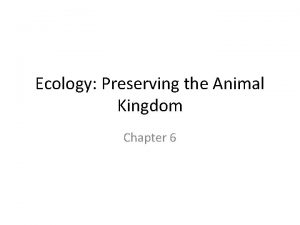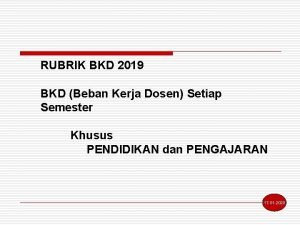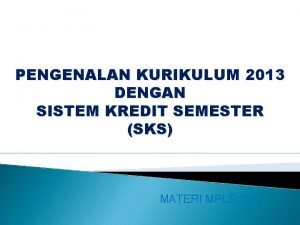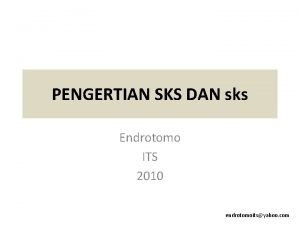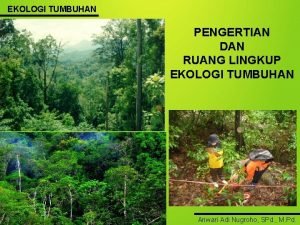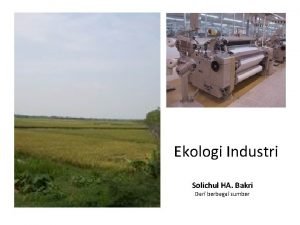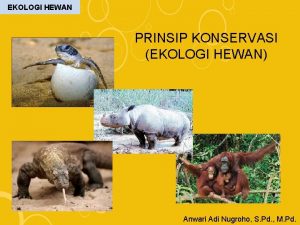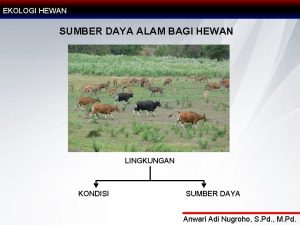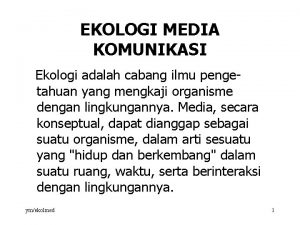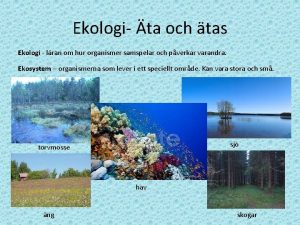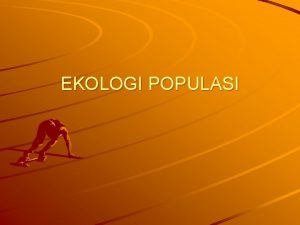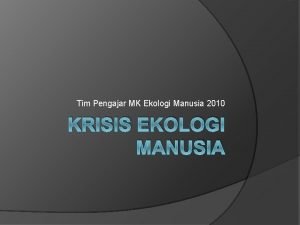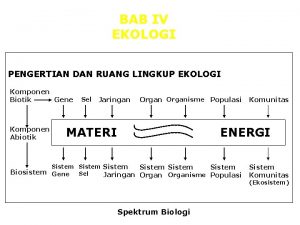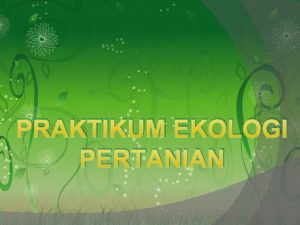Animal Ecology Ekologi Hewan 3 SKS 4314 2






















- Slides: 22

Animal Ecology (Ekologi Hewan) 3 SKS / 4314 -2 -1962

Ecology The science of the study of the relationships between living things and their environment n The environment could be: n • Biotic = other species • Nonbiological (abiotic) = physical, chemical, geographical, geological factors

Ecology The study of the distribution and abundance of organisms. Charles Elton, Animal Ecology 1927

Ecology The scientific study of the relationships between organisms and their environments. E. Haeckel, 1865

Ecology The study of the flows of energy and materials between abiotic and biotic components of ecosystems. Chapin, Mooney and Matson, 2002

Ecology is The study of the distribution and abundance of organisms, AND the flows of energy and materials between abiotic and biotic components of ecosystems.

Ecosystem n Ecosystem = community (all biotic) & physical environment (all abiotic)

Ecological sciences n General ecology n Animal ecology, plant ecology, microbial ecology n Environmental science n Environmental protection and management n Hydrobiology (water ecosystems) n Limnology (freshwater ecosystems) n Environmental geology and geography

Applications of Animal Ecology • Medical ecology • Preventive medicine (hygiene) • Toxicology • Medical parasitology • Medical microbiology • Veteriner

Basic ecological terms

Population • A group of individuals of the same species living in the same area or interbreeding and sharing genetic information. Population of species A Population of species B

Ecosystem § Ecosystem = community (all biotic) & physical environment (all abiotic) § Biological community and nonbiological factors § It must include: üAn autotroph üA decomposer üA source of energy üAll the chemical elements required by the autotroph and the decomposer

Ecosystem Abiotic factors Population of species A Community Population of species C Population of species B

Habitat • Habitat = any part of the Earth where a species can live, temporarily or permanently • = organism’s physical surroundings • = where an organism lives

Ecological Niche • Ecological Niche = functional role of a species in the community, including habitat, activities & relationships • = what an organism does, its occupation

Food web (trophic „chain“) Solar energy Producers (green plants, algae, autotrophic bacteria) Release of inorganic nutrients Secodary consumers (carnivores) Primary consumers (herbivores) Decay of organic matter Decomposers (heterotrophic bacteria, fungi)

Main Structural Components of an Ecosystem Heat Abiotic chemicals (carbon dioxide, oxygen, nitrogen, minerals) Heat Producers (plants) Decomposers bacteria, fungi) Heat Consumers (herbivores, carnivores) Heat Solar energy

Energy flow within food web Loss of energy Biomass of secondary consumers Biomass of primary consumers Biomass of producers Loss of energy

What is productivity? § Productivity: growth rate of all living things § Primary productivity: growth rate of producers § Solar energy converted to organic matter (biomass) § Stored in living organisms § All organisms depend on primary producers for their energy supply § Usually measured as grams of carbon per square meter § Primary production is consumed, converted to detritus, or accumulated in biomass

What controls productivity? • “Limiting factors” - Too much or too little of any abiotic factor can limit or prevent growth of a population • Predators: grazers • Every part of the food web will have different controls • What could be a limiting factor in the Limboto lake?

Interspecific relations Relation Neutralism Commensalism Protocooperation Mutualism („symbiosis“) Allelopathy (inhibition) Species A 0 + + + Species B 0 0 + + 0 (+? ) – Parasitism Predation Competition + + + – – – No relation, neither effects the other Free relation Closed relation Species A produces compounds harmful for species B. „antibiosis“

See you next week! Individual assignment on Interspecific relations!
 Perbandingan hewan vertebrata dan avertebrata
Perbandingan hewan vertebrata dan avertebrata Ecology preserving the animal kingdom
Ecology preserving the animal kingdom Sks
Sks Status sks
Status sks Sks welding systems
Sks welding systems Status sks
Status sks Sks psikologi gunadarma
Sks psikologi gunadarma Sks
Sks Sks kartoni
Sks kartoni Contoh unary relationship
Contoh unary relationship Sks zero
Sks zero Sks adalah
Sks adalah Gunadarma sistem informasi
Gunadarma sistem informasi Komplement kuta
Komplement kuta 1 sks berapa jp
1 sks berapa jp Minus of meeting
Minus of meeting Endrotomo its
Endrotomo its Sks lran
Sks lran Falm sks
Falm sks Sks
Sks Kondensasj
Kondensasj Ruang lingkup ekologi tumbuhan
Ruang lingkup ekologi tumbuhan Ekologi industri
Ekologi industri

